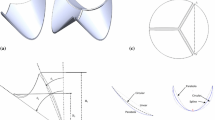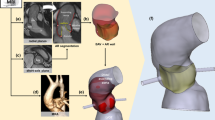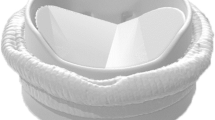Abstract
The aim of this study was to reconcile some of our own previous work and the work of others to generate a physiologically realistic numerical simulation environment that allows to virtually assess the performance of BMHVs. The model incorporates: (i) a left ventricular deformable model to generate a physiological inflow to the aortic valve; (ii) a patient-specific aortic geometry (root, arch and descending aorta); (iii) physiological pressure and flow boundary conditions. We particularly studied the influence of downstream geometry, valve size and orientation on leaflet kinematics and functional indices used in clinical routine. Compared to the straight tube geometry, the patient-specific aorta leads to a significant asynchronous movement of the valve, especially during the closing of the valve. The anterior leaflet starts to close first, impacts the casing at the closed position and remains in this position. At the same time, the posterior leaflet impacts the pivoting mechanisms at the fully open position. At the end of systole, this leaflet subsequently accelerates to the closed position, impacting the casing with an angular velocity of approximately −477 rad/s. The valve size greatly influences the transvalvular pressure gradient (TPG), but does not change the overall leaflet kinematics. This is in contrast to changes in valve orientation, where changing valve orientation induces large differences in leaflet kinematics, but the TPG remains approximately the same.










Similar content being viewed by others
References
Annerel, S., J. Degroote, T. Claessens, S. K. Dahl, B. Skallerud, L. R. Hellevik, P. Van Ransbeeck, P. Segers, P. Verdonck, and J. Vierendeels. A fast strong coupling algorithm for the partitioned fluid–structure interaction simulation of BMHVs. Comput. Methods Biomech. Biomed. Eng. 15:1281–1312, 2012.
Annerel, S., J. Degroote, T. Claessens, P. Segers, P. Verdonck, and J. Vierendeels. The upstream boundary condition influences the leaflet opening dynamics in the numerical FSI simulation of an aortic BMHV. Int. J. Numer. Methods Biomed. Eng. 28:745–760, 2012.
Annerel, S., J. Degroote, J. Vierendeels, T. Claessens, P. Van Ransbeeck, S. K. Dahl, B. Skallerud, L. R. Hellevik, P. Segers, and P. Verdonck. Application of a strong FSI coupling scheme for the numerical simulation of bileaflet mechanical heart valve dynamics: study of wall shear stress on the valve leaflets. Prog. Comput. Fluid Dyn. 12:68–79, 2012.
Baumgartner, H., S. S. Khan, M. DeRobertis, L. S. Czer, and G. Maurer. Doppler assessment of prosthetic valve orifice area. An in vitro study. Circulation 85:2275–2283, 1992.
Borazjani, I., L. Ge, and F. Sotiropoulos. High-resolution fluid–structure interaction simulations of flow through a bi-leaflet mechanical heart valve in an anatomic aorta. Ann. Biomed. Eng. 38:326–344, 2010.
Borazjani, I., and F. Sotiropoulos. The effect of implantation orientation of a bileaflet mechanical heart valve on kinematics and hemodynamics in an anatomic aorta. J. Biomech. Eng. 132:111005, 2010.
Butterfield, M., J. Fisher, G. A. Davies, and T. J. Spyt. Comparative study of the hydrodynamic function of the carbomedics valve. Ann. Thorac. Surg. 52:815–820, 1991.
Chambers, J., J. Cross, P. Deverall, and E. Sowton. Echocardiographic description of the carbomedics bileaflet prosthetic heart valve. J. Am. Coll. Cardiol. 21:398–405, 1993.
Cheng, Y., H. Oertel, and T. Schenkel. Fluid–structure coupled CFD simulation of the left ventricular flow during filling phase. Ann. Biomed. Eng. 33:567–576, 2005.
Choi, H. F., J. D’Hooge, F. E. Rademakers, and P. Claus. Influence of left-ventricular shape on passive filling properties and end-diastolic fiber stress and strain. J. Biomech. 43:1745–1753, 2010.
Eichinger, W. B., I. Hettich, S. Bleiziffer, R. Gunzinger, A. Hutter, R. Bauernschmitt, and R. Lange. Intermittent regurgitation caused by incomplete leaflet closure of the medtronic advantage bileaflet heart valve: analysis of the underlying mechanism. J. Thorac. Cardiovasc. Surg. 140:611–616, 2010.
Gorlin, R. Calculations of cardiac valve stenosis: restoring an old concept for advanced applications. J. Am. Coll. Cardiol. 10:920–922, 1987.
Gorlin, R., and S. G. Gorlin. Hydraulic formula for calculation of the area of the stenotic mitral valve, other cardiac valves, and central circulatory shunts. I. Am. Heart J. 41:1–29, 1951.
Hammermeister, K. E., and J. R. Warbasse. The rate of change of left ventricular volume in man. II. Diastolic events in health and disease. Circulation 49:739–747, 1974.
Hatle, L., B. Angelsen, and A. Tromsdal. Noninvasive assessment of atrioventricular pressure half-time by Doppler ultrasound. Circulation 60:1096–1104, 1979.
Ihlen, H., P. Molstad, S. Simonsen, K. Vatne, E. Ovrum, O. Geiran, P. Laake, and T. Froysaker. Hemodynamic evaluation of the carbomedics prosthetic heart valve in the aortic position: comparison of noninvasive and invasive techniques. Am. Heart J. 123:151–159, 1992.
Johansen, P. Mechanical heart valve cavitation. Expert Rev. Med. Devices 1:95–104, 2004.
Kim, H. J., I. E. Vignon-Clementel, C. A. Figueroa, J. F. LaDisa, K. E. Jansen, J. A. Feinstein, and C. A. Taylor. On coupling a lumped parameter heart model and a three-dimensional finite element aorta model. Ann. Biomed. Eng. 37:2153–2169, 2009.
Le, T. B., and F. Sotiropoulos. Fluid–structure interaction of an aortic heart valve prosthesis driven by an animated anatomic left ventricle. J. Comput. Phys. 244:41–62, 2013.
Rajani, R., D. Mukherjee, and J. B. Chambers. Doppler echocardiography in normally functioning replacement aortic valves: a review of 129 studies. J. Heart Valve Dis. 16:519–535, 2007.
Riemslagh, K., J. Vierendeels, and E. Dick. Two-dimensional incompressible navier-stokes calculations in complex-shaped moving domains. J. Eng. Math. 34:57–73, 1998.
Riemslagh, K., J. Vierendeels, and E. Dick. An arbitrary lagrangian-eulerian finite-volume method for the simulation of rotary displacement pump flow. Appl. Numer. Math. 32:419–433, 2000.
Rosenhek, R., T. Binder, G. Maurer, and H. Baumgartner. Normal values for Doppler echocardiographic assessment of heart valve prostheses. J. Am. Soc. Echocardiogr. 16:1116–1127, 2003.
Schenkel, T., M. Malve, M. Reik, M. Markl, B. Jung, and H. Oertel. Mri-based CFD analysis of flow in a human left ventricle: methodology and application to a healthy heart. Ann. Biomed. Eng. 37:503–515, 2009.
Verdonck, P., J. Vierendeels, K. Riemslagh, and E. Dick. Left-ventricular pressure gradients: a computer-model simulation. Med. Biol. Eng. Comput. 37:511–516, 1999.
Verdonck, P. R., K. Dumont, P. Segers, S. Vandenberghe, and G. Van Nooten. Mock loop testing of on-x prosthetic mitral valve with Doppler echocardiography. Artif. Organs 26:872–878, 2002.
Watanabe, H., S. Sugiura, H. Kafuku, and T. Hisada. Multiphysics simulation of left ventricular filling dynamics using fluid–structure interaction finite element method. Biophys. J. 87:2074–2085, 2004.
Xiong, G. Computational methods of modeling vascular geometry and tracking pulmonary motion from medical images. Dissertation, Stanford University, 2011. http://purl.stanford.edu/rv373cz9473.
Yoganathan, A. P., Z. He, and S. Casey Jones. Fluid mechanics of heart valves. Annu. Rev. Biomed. Eng. 6:331–362, 2004.
Zapanta, C. M., D. R. Stinebring, S. Deutsch, D. B. Geselowitz, and J. M. Tarbell. A comparison of the cavitation potential of prosthetic heart valves based on valve closing dynamics. J. Heart Valve Dis. 7:655–667, 1998.
Zoghbi, W. A., J. B. Chambers, J. G. Dumesnil, E. Foster, J. S. Gottdiener, P. A. Grayburn, B. K. Khandheria, R. A. Levine, G. R. Marx, F. A, Miller Jr., S. Nakatani, M. A. Quinones, H. Rakowski, L. L. Rodriguez, M. Swaminathan, A. D. Waggoner, N. J. Weissman, and M. Zabalgoitia. Recommendations for evaluation of prosthetic valves with echocardiography and doppler ultrasound: A report from the american society of echocardiography’s guidelines and standards committee and the task force on prosthetic valves, developed in conjunction with the american college of cardiology cardiovascular imaging committee, cardiac imaging committee of the american heart association, the european association of echocardiography, a registered branch of the european society of cardiology, the japanese society of echocardiography and the canadian society of echocardiography, endorsed by the american college of cardiology foundation, american heart association, european association of echocardiography, a registered branch of the european society of cardiology, the japanese society of echocardiography, and canadian society of echocardiography. J. Am. Soc. Echocardiogr. 22:975–1014; quiz 1082–1014, 2009.
Acknowledgments
The authors would like to acknowledge Vivek Muthurangu from the UCL Institute of Child Health London and Joseph Panzer from the department of paediatric cardiology from the University Hospital of Ghent for the use of the Os4irix plug-ins and for the assessment of the MRI data. The authors gratefully acknowledge the financial support of UGent (GOA grant from BOF) and FWO.
Author information
Authors and Affiliations
Corresponding author
Additional information
Associate Editor Umberto Morbiducci oversaw the review of this article.
Appendices
Appendix A: Three-Element Windkessel Model
At the outlet of the descending aorta, a physiological blood pressure profile is imposed using a three-element windkessel model and the patient-specific MR flows in the descending aorta. The windkessel consists of three elements: the resistance R, the characteristic impedance Z 0 and the compliance C. Appropriate values for these parameters are calculated as follows.
The resistance R is calculated by
wherein Q mean and p mean represent, respectively, the mean patient-specific MR flow and the mean pressure level in the descending aorta (assessed proximal to renal artery branching).
The characteristic impedance Z 0 is obtained from the following equation:
The parameter ρ is the density of blood, c is the pulse wave velocity, and A is the outlet area of the descending aorta.
The compliance C is set equal to 1 mL/mmHg, as is commonly done in literature.
All the parameter values agree with (Kim et al.18; Xiong28).
The resulting blood pressure profile is visualized in Fig. 4b.
Appendix B: Left Ventricular Volume Change
In this section, the equations that describe the volume of the LV during the diastolic expansion are derived.
Since no volume changes of the LV can be obtained from the MR dataset, the diastolic expansion of the LV needs to be modelled. The following data are available from the patient-specific MR dataset, as already discussed in “Fluid–Structure Interaction of the BMHV”: the systolic flow rate (of which SV fwd is calculated), the ESV (obtained from the patient-specific LV geometry) and the heart rate. From these parameters, the diastolic phase can be modelled by adapting a statistical diastolic LV expansion model with these data. Hereafter, this is discussed in more detail.
The volume of the LV during diastolic filling is solved piecewise by three functions (V 1(t), V 2(t) and V 3(t)), representing, respectively, the RF-phase, the SF-phase and the AC-phase of the LV:
In order to obtain the appropriate values for the 14 unknowns (a i , b i and c i ), the following equations are solved, based on experimentally parameters obtained in14:
Isovolumetric relaxation:
Peak rapid filling (pRF):
End of rapid filling (eRF):
Peak slow filling (pSF):
End of slow filling (eSF):
Peak atrial contraction (pAC):
End of diastole:
Moreover, since a time cycle of 0.96 s is used in,14 the time levels of14 need to be scaled to the period of 0.84 s. The used values are:
Solving previous equations results in the diastolic expansion as visualized in Figs. 4c–4d.
Rights and permissions
About this article
Cite this article
Annerel, S., Claessens, T., Taelman, L. et al. Influence of Valve Size, Orientation and Downstream Geometry of an Aortic BMHV on Leaflet Motion and Clinically Used Valve Performance Parameters. Ann Biomed Eng 43, 1370–1384 (2015). https://doi.org/10.1007/s10439-014-1102-9
Received:
Accepted:
Published:
Issue Date:
DOI: https://doi.org/10.1007/s10439-014-1102-9




